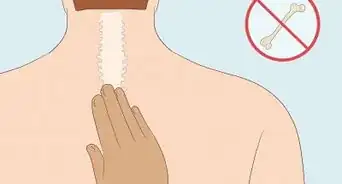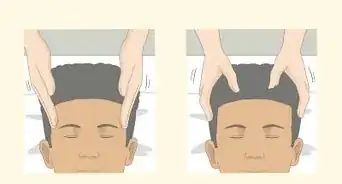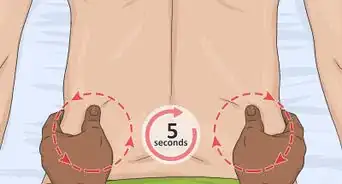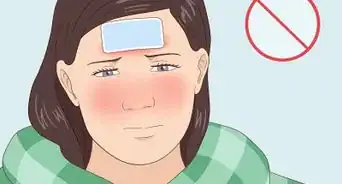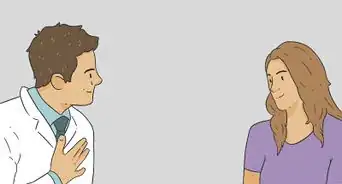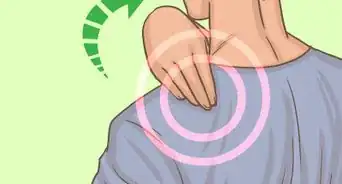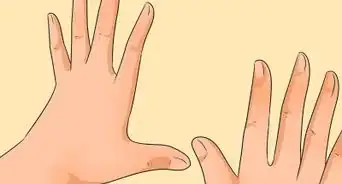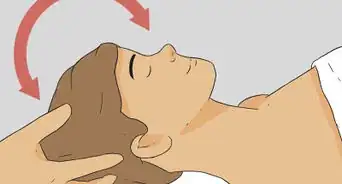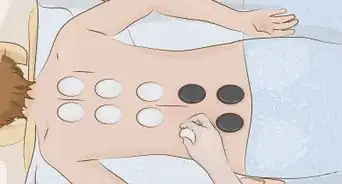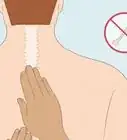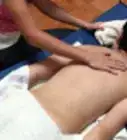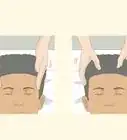This article was co-authored by Will Fuller. Will Fuller is a Certified Massage Therapist and Wellness Educator working in San Francisco, California. Will has worked with the Sports and Recreation Center at the University of California, San Francisco (UCSF), taught sports in England, Kenya, and Kuwait, and is now affiliated with the Chiro-Medical Group. He was trained in physical rehabilitation under a program founded by Dr. Meir Schneider. He has a Bachelors in Sport Science and a Post-Graduate Certificate of Education in Physical Education from Southampton University.
wikiHow marks an article as reader-approved once it receives enough positive feedback. This article received 17 testimonials and 95% of readers who voted found it helpful, earning it our reader-approved status.
This article has been viewed 1,223,024 times.
The Indian head massage, also known by the portmanteau "champissage" (chämpi—the Indian word for massage in many dialects + massage), is based on the ancient Ayurvedic form of healing that dates back almost 4,000 years. It works the upper three chakras: vishuddha, ajna, and sahasrara, [1] and can be used for physical harmony, for healing, for vitality, and for good, old-fashioned relaxation. No wonder it's becoming so popular in the west! For instructions on how to perform the Indian head massage, read this article.
Steps
Preparations and Starting Off
-
1Make preparations. Find a quiet place away from any distractions. Make sure the room is a comfortable temperature.
- Put on some soft music
- Light some candles to prepare the room.
-
2Have the recipient take a seat and get comfortable. Explain what you will be doing, and tell them to notify you of any discomfort or pain. Stand behind, placing your hands lightly on their shoulders as you both take several deep breaths.Advertisement
-
3Massage the shoulders. Begin easing away fatigue and tensions with an upper back, shoulders, arms, and neck massage. Squeeze the trapezius muscle (at the base of the neck) gently, starting close to the neck. Work your way outward to the shoulder. Repeat this three times, allowing the pressure to increase with each pass.
-
4Work in towards the spine. Bring your hands back up next to the neck with the thumbs extended, and make small circles with the thumbs on either side of the backbone just below the collar line.
-
5Massage the tops of the shoulders. Place your forearms at the sides of the neck and roll them outwards toward the shoulder by rotating at the wrists. After rotating, lift your forearms and move them a couple of inches away from the neck and repeat. When you reach the shoulder, come back to center and repeat this process two more times.
Massaging the Neck
-
1Work up to the base of the skull. Continue with the circles up the back of the neck until you reach the hairline. Lower your hands back down and repeat two more times.
-
2Massage the neck. Step to one side of your volunteer, and place one hand at the base of the recipient's neck, and your front hand gently on their forehead to keep their head from falling forward. With the rear hand, open your thumb and glide your hand up the back of the neck. Don't put pressure directly on the vertebrae.
- Once you reach the hairline, remain there for a moment with light pressure on the back of the head. Lower your rear hand and repeat from the base of the neck. You can even add some circling to the upward stroke if there seems to be a lot of tension present. Repeat this about five times. When your rear hand reaches the hairline for the last time, let it remain there.
-
3Slowly allow the head to tilt forward without strain or effort. Keep your hand at the recipient's hairline.
-
4Move the head back. Gently lift the head back to vertical and continue backwards, again without forcing, simply allowing the head to move within its own range of motion.
- Repeat this 3 times, forward and backward.
Massaging the Head
-
1Massage the head. Step back behind the recipient and loosen his or her hair if it is restrained. Bring your hands, with fingers spread, to the sides of the head, fingers pointing up. Use a light pressure and slowly move the hands up with a shampooing-like motion, trying to keep the heel of the hands in contact with the scalp as well as the fingers.
- Once you reach the top of the head, allow the fingers to rise off while maintaining a gentle traction from the heels of the hands. Now lower your hands and move them around to a different area of the head. Repeat four or five times, covering the entire scalp.
-
2Rub the scalp. Bring one hand to the volunteer's forehead for stability as you place the heel of the other hand in contact with back of the head. Begin rubbing the scalp by moving your rear hand vigorously back and forth. Continue rubbing as much of the scalp as you can reach, and then switch hands and repeat on the other side.
-
3Briskly rub the scalp all over with just the fingertips of both hands. Continue this for about a minute.
-
4Stroke your fingers through your recipient's hair from the top of the forehead back. Let the final strokes draw their head back slightly and then lay the fingers over the forehead and draw the fingers down and along the brow line to each temple, making small circles over the temples. Repeat this process three times.
-
5Finish up. With smooth strokes beginning at the forehead, slowly work your way to the back of the head. Do this for about a minute, allowing the pressure to become lighter towards the end, until finally your hands float off the head.
-
6Know the benefits. The therapeutic benefits of the Indian head massage are comprehensive, suggesting that you make it a part of your overall health routines. They include:
- Relief from pain and stiffness in the muscles of the face, neck, upper back, and shoulders.
- Increased mobility of the neck joints.
- Relief from tension and hangover headaches, eye strain, TMJ, and nasal congestion
- Renewed energy.
- Reduction of depression, anxiety, and other stress-related issues
- Higher levels of creativity, clarity, and concentration, and better memory.
- A sense of tranquility, calmness, and positive well-being.
- Sound, restful sleep that leaves you refreshed.
- Deeper, calmer respiratory system.
- Stronger immune system.
- Improved skin tone, health, and colour.
- Healthy hair and scalp.
- Increased self-esteem and self-worth with greater self-awareness
- Balanced chakras.
Community Q&A
-
QuestionDoes this really work?
 Community AnswerYes. However, some people feel the benefits better and stronger than others, but anyone who receives this massage (when done correctly) should feel relaxed and renewed.
Community AnswerYes. However, some people feel the benefits better and stronger than others, but anyone who receives this massage (when done correctly) should feel relaxed and renewed. -
QuestionCan I lie down during an Indian head massage? I felt dizzy after a massage and my blood pressure dropped. Was this because my head was placed in a hole for my face in a treatment bed?
 Community AnswerYou may lie down; it is even better for the body. You might have been dizzy because you had more blood flow to the head. A careful IHM practitioner would know the ways to balance it.
Community AnswerYou may lie down; it is even better for the body. You might have been dizzy because you had more blood flow to the head. A careful IHM practitioner would know the ways to balance it. -
QuestionWhich oil is good for relaxation?
 Community AnswerLavender, elemi, ylang-ylang, frankincense, sometimes cedarwood, or any of the relax blends from essential oil companies.
Community AnswerLavender, elemi, ylang-ylang, frankincense, sometimes cedarwood, or any of the relax blends from essential oil companies.
Warnings
- If using massage oil, make sure the person being massaged isn't allergic to it.⧼thumbs_response⧽
- If, while you are performing this massage, your volunteer feels any pain, immediately stop the massage.⧼thumbs_response⧽
References
About This Article
If you want to give someone an Indian head massage, start by sitting them in a chair and standing behind them with your hands on their shoulders. Begin the massage by gently squeezing and rubbing their shoulder muscles while using your thumbs to work the muscles on the sides of the spine. From there, move your thumbs in circles up the neck to their hairline. Once you’re at the hairline, use one hand to hold their forehead in place while gliding your other hand up the back of their neck. As you do this, slowly tilt their head forward then backward. Finally, move your hands to their scalp and rub all over their head with your fingertips, working your way from the browline to the back of the head. For more help, like how to understand the benefits of an Indian head massage, read on.



